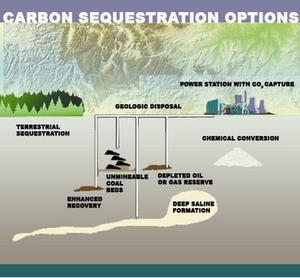CO2 sequestrationU.S. geological carbon dioxide storage potential
The United States has the potential to store a mean of 3,000 metric gigatons of carbon dioxide (CO2) in geologic basins throughout the country. Technically accessible storage resources are those that can be accessed using today’s technology and pressurization and injection techniques. The most common method of geologic carbon storage involves pressurizing CO2 gas into a liquid, and then injecting it into subsurface rock layers for long-term storage.

Several ideas under considertion for carbon sequestration // Source: llnl.gov
The United States has the potential to store a mean of 3,000 metric gigatons of carbon dioxide (CO2) in geologic basins throughout the country, according to the first-ever detailed national geologic carbon sequestration assessment released last week by the U.S. Geological Survey (USGS). The assessment comes on the heels of a national plan to combat climate change announced by President Obama.
“This USGS research is ground-breaking because it is the first realistic view of technically accessible carbon storage capacity in these basins,” said Secretary of the Interior Sally Jewell. “If enough of this capacity also proves to be environmentally and economically viable, then geologic carbon sequestration could help us reduce carbon dioxide emissions that contribute to climate change.”
The USGS reportsthat based on present-day geologic and hydrologic knowledge of the subsurface and current engineering pracitices, this assessment looked at the potential for CO2 storage in thirty-six basins in the United States.
The largest potential by far is in the Coastal Plains region, which accounts for 2,000 metric gigatons, or 65 percent, of the storage potential. Two other regions with significant storage capacity include the Alaska region and the Rocky Mountains and Northern Great Plains region.
Technically accessible storage resources are those that can be accessed using today’s technology and pressurization and injection techniques. The most common method of geologic carbon storage involves pressurizing CO2 gas into a liquid, and then injecting it into subsurface rock layers for long-term storage.
“Today’s assessment from the USGS is just the latest example of how the Department of the Interior is applying rigorous, peer-reviewed science to some of our nation’s most complex land- and resource-management challenges,” said Deputy Secretary David J. Hayes. “Nowhere is this more important than the issue of climate change, and today’s new research adds to the USGS’s groundbreaking work in biological carbon sequestration to better inform our carbon reduction efforts.”
This assessment goes further than all previous assessments in considering the viability of sequestration. For example, all areas with groundwater sources that are considered freshwater by U.S. Environmental Protection Agency (EPA) standards were eliminated from consideration for carbon storage resource potential in this assessment. In addition, the rock layers included in the assessment were limited to those determined to have sufficient natural seals to prevent CO2 from escaping. This assessment also focused only on rock layers located at depths at which CO2 would stay under sufficient pressure to remain liquid.
The study did not evaluate economic
